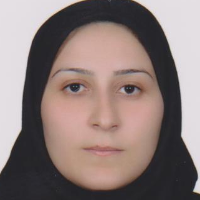Geochemical and Palynological analysis of Lake Gahar's sediment core in high Zagros Mountains
Abstract:
Dynamic change and great endangered oak forests have characterized the Zagros Mountain as an attractive site to study. There are some palynological and geochemical studies in the north and northwest of Iran where is located in a moderate elevation. The motivation for this study is to reconstruct the past environment of high part of Zagros Mountain in order to find the climate change.
In this research the geochemical results are more significant. The V/Cr index demonstrated three significant pick throughout the core which is in conjunction with abundance of aquatic plants (Sparganium and Cyperaceae) and also trees and herbs such as oak and grass pollens. It seems that the disappearing of arboreal pollen, especially Quercus at a depth of 50 and 60 cm at the boundary between GHC and GHD is associated with unfavorable temperature conditions for plant growth however V/Cr ratio is in highest amount during this period. In addition the minimum amount of V/Cr ratio can be as a sign of warm and dry period with decrement of annual precipitation. It is also concluded that the maximum V/Cr ratio can be an indicator of increasing annual precipitation during three major time phases in high Zagros Mountains.
Materials And Methods
This research is a sedimentological and palynological study of a three meters sediment core from Lake Gahar located in high Zagros Mountain in Lorestan Province. In order to study the paleoclimatic condition in this region a multi-proxy approach consist of geochemistry and palynology has done. We used Auger corer device for sampling two cores GH1& GH2 in vicinity of each other from 49ₒ16'23"E, 33ₒ18'00"N for palynology and sedimentology separately in summer 2014. The sub-samples from GH2 used by 20 cm interval distance for geochemical process and analyzed by inductively coupled plasma emission spectroscopy (ICP) method and the indices have analyzed. In this study 30 samples of GH1 were used with interval distance equal 10 cm for palynology. The pollen extraction followed the chemical treatment methods based on Moor et al. (1991). The chemical treatment carried out at department of Palynology and Climate Dynamics situated at Georg-August-University of G ttingen, Albrecht-von-Haller-Institute for Plant Sciences (Göttingen, Germany). Pollen determinations were performed by using the institute pollen reference slides collection and pollen atlases of Reille (1992, 1995, 1998), Beug (2004) and pollen morphological descriptions by Van Zeist and Bottema (1977). Then, during microscopic analysis, we identified and counted the pollen grains by magnification equal 400X by Zeiss. The pollen diagram was drawn by the aide of Tilia (version 1.7.16) software. The radiocarbon dating method was used for samples and the data of annual precipitation and temperature reconstructed based on MCM model during 8000 yrs. BP.Results And Discussion
According to the pollen percentage diagram of Lake Gahar (Figs. 6 to 8), four main local pollen assemblage zones consisting of two older zones GHA (depth of 300 to 290 cm), GHB (290 to 110 cm depth) and two earlier zones GHC (depth 110 to 50 cm) and GHD (depth 50 to 0 cm) were identified. Then geochemical analysis was performed for the second core in Geological Survey of Iran. Three major ratios consist of V/Cr, V/Mo, and Co/Ni calculated based on ICP results. The V/Cr ratio considered as an indicator for the interpretation of past sedimentary environment of study region and also climate change and supported by pollen analysis results. The maximum amounts of V/Cr ratio were found in three major depths of 40-60,120-140, and 200-220 cm. Cluster analysis for the pollen frequency indicated four distinct zones; from base to the top are respectively GHA, GHB, GHC and GHD. This zonation was induced based on arboreal and/ or none arboreal pollen.Conclusions
The results showed that the two zones GHA and GHB coincide with expansion of forest-steppe vegetation of oak as the dominant species. It seems that the positive fluctuation of temperature caused more frequency of arboreal pollen.In this research the geochemical results are more significant. The V/Cr index demonstrated three significant pick throughout the core which is in conjunction with abundance of aquatic plants (Sparganium and Cyperaceae) and also trees and herbs such as oak and grass pollens. It seems that the disappearing of arboreal pollen, especially Quercus at a depth of 50 and 60 cm at the boundary between GHC and GHD is associated with unfavorable temperature conditions for plant growth however V/Cr ratio is in highest amount during this period. In addition the minimum amount of V/Cr ratio can be as a sign of warm and dry period with decrement of annual precipitation. It is also concluded that the maximum V/Cr ratio can be an indicator of increasing annual precipitation during three major time phases in high Zagros Mountains.
Keywords:
Iran , Paleoclimate , Palynology , Sedimentology , V , Cr ratio
Language:
Persian
Published:
Quaternery journal of Iran, Volume:2 Issue: 5, 2016
Pages:
27 to 40
magiran.com/p1600929
دانلود و مطالعه متن این مقاله با یکی از روشهای زیر امکان پذیر است:
اشتراک شخصی
با عضویت و پرداخت آنلاین حق اشتراک یکساله به مبلغ 1,390,000ريال میتوانید 70 عنوان مطلب دانلود کنید!
اشتراک سازمانی
به کتابخانه دانشگاه یا محل کار خود پیشنهاد کنید تا اشتراک سازمانی این پایگاه را برای دسترسی نامحدود همه کاربران به متن مطالب تهیه نمایند!
توجه!
- حق عضویت دریافتی صرف حمایت از نشریات عضو و نگهداری، تکمیل و توسعه مگیران میشود.
- پرداخت حق اشتراک و دانلود مقالات اجازه بازنشر آن در سایر رسانههای چاپی و دیجیتال را به کاربر نمیدهد.
In order to view content subscription is required
Personal subscription
Subscribe magiran.com for 70 € euros via PayPal and download 70 articles during a year.
Organization subscription
Please contact us to subscribe your university or library for unlimited access!



